Battle For Okinawa: World War II home
"The Perfect Pillbox"
Religious and almost indestructible Pillbox; sort - of...
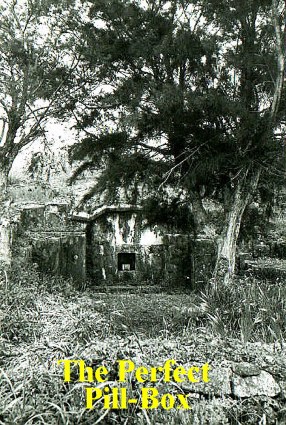 Just When Things Couldn't Get Worse...
Just When Things Couldn't Get Worse...Imagine. Your mission is to get on the Beach; past the machine-guns over-the sea wall, past the caves, thru the jungles, up the ravines and around the corner you run into
"The Perfect Pillbox"
Kamekobaka is the typical style of tombs in Okinawa.
(Some of these Tomb Photos credited to Dave and Cindy Lovelace but I have no idea which ones)
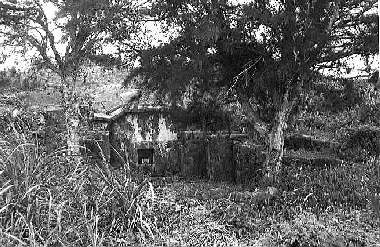
Okinawan Tomb and Japanese Defensive Position
Trees and shrubs were planted in-front of nearly every tomb
which helped camouflage them from the ground and the air.
These types of tombs are called "kamekobaka"(turtle-back tombs) and the
resourceful Japanese Army made good use of their defensive and tactical value.

War Battered and more recessed Tomb probably fronting
a Cave entrance
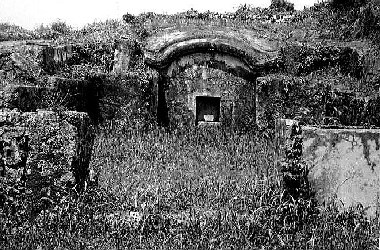
Around every corner; on the side of every ravine and
dug into the hillside of every hill; Concrete reinforced pillboxes
Battleship shells are said to have glanced off their tops
unless they took a direct hit at the entrance.
Bulls-Eye...Almost
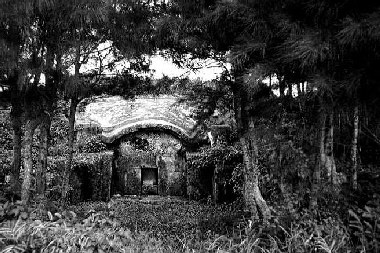
Here is a Tomb that took an almost direct hit during the war
A little too high and to the left;
the round only left little more than a dent...
I judged the thickness of these tomb 'fronts' at about 3 foot
of quarried stone or cement rock with reinforced re-barr in some cases
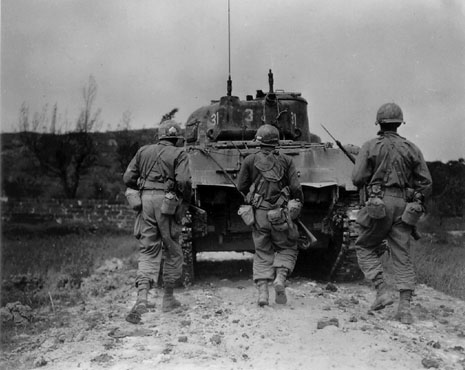
American Tank on Okinawa supported by members of an infantry Company
The Japanese on Okinawa would strap high explosives to their bodies and throw
themselves under the fronts of the tanks in suicidal waves and the tanks were used
in knocking out bunker and tomb areas used by the Japanese; the tanks equipted with
with flame-throwers were quite effective. (US Army Photo)
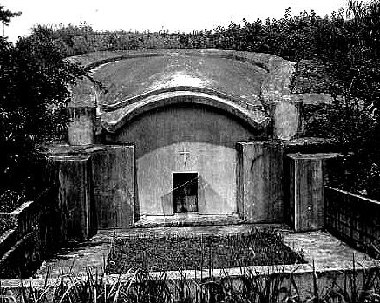
Miniature last stand fortress
The picture above shows a wall around the outside of the Tomb called a "hinpun".
The Hinpun serves as a screen between the tomb and outside observers and was the first line of defense for Japanese Infantry. Locals told me that the Japanese would use the Tombs as housing; tossing out the remains of ancestors; and they would often take 'wheeled' .37mm Cannons apart (or the Japanese equivalent) and they would
reassemble the weapons inside with only the barrels sticking out. The tombs were
ready-made air-raid shelters, and a last ditch defense network.
In more peaceful time; these tombs store the remains of relatives in urns; and the
relatives spirit is honored on Tanabata.
On Tanabata, people used to clean their family tombs, airing the entrance and washing the bones or Senkotsu (washing of the bones) means taking bones out from tombs and washing it. Times have changed. You will notice incense burners before most entrances and people light senko (incense sticks) before the tomb and offer Sake' wine to welcome back the spirits of their ancestors and guide them to the family altar.
(If you have ever had too much Sake' you might begin to see your own ancestors as well...)
Today in some instances, people only go outside their homes and pray in the direction of their family tombs. Every home has an alter and pictures of the deceased. Some light the senko on the family altar, letting their ancestors know it's Tanabata.
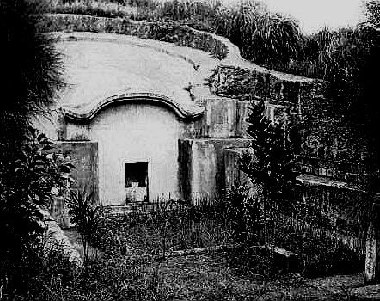
Note the Incense burner in front of the entrance
and the small trees and shrubs planted outside
In many homes, people leave tea on the altar everyday from the beginning of Tanabata until the end of Obon. Obon is celebrated with many parades, dancing and colorful
native costumes.
Also, the sun's rays are the strongest in the time of Tanabata and is called "Nanka-tida". So, this time is used as a time to air out clothes and houses and to open up grain storage bins. Rarely-worn ceremonial costumes are also taken out and aired. It is the Okinawan version of seasonal cleaning. Nanka Tida means July's sun rays, Tida meaning sun in Okinawan language.
Only the very old remember these tasks. They are hardly seen or even remembered by the younger generations There is a Tanabata celebration called "Nanka-soron" which is similar to the Tanabata held in the Kinki area of mainland Japan. This is on the island of Yaeyama, not the main island of Okinawa. In Okinawa, Tanabata is observed on the seventh day of the seventh month in the lunar calendar. It is thought of as part of Obon Festival, not as a Star Festival or Sea God Festival like in mainland Japan. Nanka means 7th day of the month and Soron means spirits in Okinawan language.
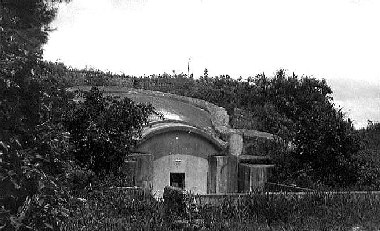
More and More of the modern tombs sport the Christian Cross
Residents told me the tombs sold for around $10,000 in 1974
and that the land they sat on cam cost even more.
There are hardly any religious observances on Tanabata, it is one of the special annual events for children from nursery school to the 1st grade. They write their wishes on small colored strips of paper and tie them to bamboo hoping these wishes will come true.
Editors Note: Side-Bar on Japanese 'Holdout' soldiers in the Pacific:
"I am sorry I did not serve his majesty to my satisfaction...We Japanese soldiers were told to prefer death to the disgrace of getting captured alive," Shoichi Yokoi captured in 1972.
Commander Charles Leonard was a navy carrier pilot during World War II and he was stationed off and on in these islands for many years thereafter.
He said; that when the service men would get time off on Okinawa they were allowed to draw ammunition and rifles and many of them spent their time hunting for Japanese Soldiers on who had not surrendered. When the Americans took the island they simply sealed off the Northern end of the island and left it up to the Japanese to surrender themselves.
The last holdout that I know of on Okinawa was captured in this area in the late 1960's or early 70's while I was taking ROTC under commander Leonard at Tascosa High School Amarillo Texas. My duty driver in the early 70's on Okinawa said he thought there might still be some of them left up there 'in the Northern end of Okinawa' and maybe they had simply blended into the local area as farmers and fishermen.
January 1972
(Guam Pacific Stars & Stripes)
Shoichi Yokoi, was found along the Talofofo River. He brought back his army-issue rifle and said "I am sorry I did not serve his majesty to my satisfaction...We Japanese soldiers were told to prefer death to the disgrace of getting captured alive,"
1974
(Philippines Pacific Stars & Stripes)
Hiroo Onoda was one of the last Japanese soldiers to surrender. Attempts were made to persuade Hiroo to surrender, including appeals from relatives. It took his former commanding officer to convince Hiroo the war was over. He had been holding out on Lubang Island in the Philippines; along with four other soldiers; one broke away from the group and surrendered and the others were killed in clashes with the Filipino Villagers. During Onoda's time since WW II; his group killed 40 villagers and wounded 100 others.
He was pardoned by Ferdinand Marcos after his surrender. After spending some time in Japan, he retired to a ranch in Brazil. Onoda recently resurfaced in May 1996, returning to the Philippines for a visit.
(Editors Note: Brazil has always maintained a 'Safe-Haven' for members of the Axis Powers since World War II. It is not known whether Onoda continued to share the Axis view of the world; but due to his 30 years at war it can be easily be assumed that he might feel more comfortable in Brazil)
TOKYO (Kyodo) -- Hiroo Onoda, 74, a former Japanese Imperial Army officer, leaves Narita airport near Tokyo for his first trip to the Philippines in 22 years to visit his former island hideout in the western Philippines. Onoda hid in the jungles of Lubang Island for about 30 years after the end of World War II.
  Lubang Island (Kyodo) -- Former Imperial Japanese Army officer Hiroo Onoda, who held out in the Philippine jungles for almost three decades after the end of World War II, lays flowers at a monument on Lubang Island in the Philippines on May 21 during his first visit in 22 years.
April 1980
Philippines - Mindoro Island
Captain of the Japanese Imperial Army, Fumio Nakahira, held out until April 1980 before being discovered at Mt. Halcon.
|